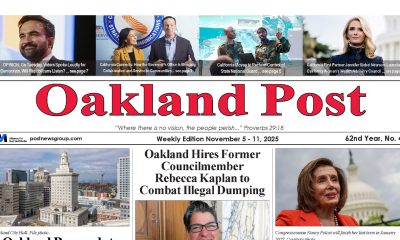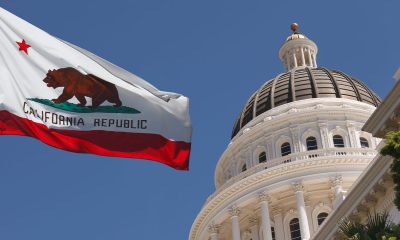Community
After a Pandemic Pause, the State Will Restart Checking Medi-Cal Eligibility
California will soon restart its annual eligibility review for people enrolled in Medi-Cal, a process that has been suspended since the onset of the COVID-19 pandemic. This means that starting in mid-April, residents enrolled in Medi-Cal, the state’s insurance program for low-income people, will start to receive renewal notices in the mail. The process will be spread over 14 months.

By Ana B. Ibarra
CalMatters
California will soon restart its annual eligibility review for people enrolled in Medi-Cal, a process that has been suspended since the onset of the COVID-19 pandemic.
This means that starting in mid-April, residents enrolled in Medi-Cal, the state’s insurance program for low-income people, will start to receive renewal notices in the mail. The process will be spread over 14 months. Some people may be automatically re-enrolled, but most people will have to fill out a renewal packet with information about their income and household size. People who no longer qualify or who fail to fill out the paperwork will lose their free or low-cost coverage.
State officials estimate that between 2 million and 3 million people could lose their Medi-Cal coverage. Ideally, people who no longer qualify for Medi-Cal will transition to a plan in the state’s insurance marketplace, Covered California, or to a job-sponsored health plan. Still, health advocates worry that many people could fall through the cracks or get caught in administrative hurdles and become uninsured, leaving them more likely to delay or forgo care altogether.
Currently, 15.4 million people — more than a third of the state’s population — are enrolled in Medi-Cal, the most ever, according to the California Department of Health Care Services. That’s partly a result of the increased need during the pandemic: As people lost jobs and wages, many also lost their medical insurance. From March 2020 to February 2023, Medi-Cal enrollment increased 16%, according to the department.
And as thousands of people became newly eligible for Medi-Cal, far fewer were coming off. Federal rules prohibited states from dropping people from government-sponsored insurance during the pandemic as a way to protect access to care. Now those federal rules are lapsing.
California’s renewal process will restart on April 1 and should be completed around June 2024, meaning people can receive their renewal notices and paperwork anytime during this time period. Those who in the past have renewed in the month of June will get their paperwork first, said Yingjia Huang, assistant deputy director for health care benefits and eligibility at the Department of Health Care Services. This phased-in approach will help spread the caseload for county offices in charge of the review, Huang said, and also allow enrollees who have renewed in the past to keep a similar timeline.
To qualify for Medi-Cal, people can earn up to 138% of the federal poverty level — that’s $20,121 a year for an individual or $41,400 for a family of four. Some Californians, such as pregnant women and people with disabilities, may qualify with slightly higher incomes.
People who were eligible for Medi-Cal at some point during the pandemic, but who may no longer qualify because their income has increased, will be automatically transitioned into a similar plan through Covered California, Huang said.
“The system automatically will review their eligibility for Covered California and Covered California will send out the enrollment notice to the member, informing them of their options and to pay the plan premium. So there’s no administrative burden on a member,” Huang said. “We’re trying to make sure that process is seamless and streamlined.”
Whether people successfully make the switch will largely depend on their ability to pay their new monthly premium.
Most people who buy from the marketplace receive generous subsidies, and some people don’t have a premium cost at all. Nearly half of the people enrolled in coverage through Covered California pay less than $50 a month, according to the agency. Still, even a $5 premium, along with the accompanying deductibles and copays, can discourage people from buying a health plan, said John Baackes, CEO of L.A Care, which offers Medi-Cal and Covered California plans to Los Angeles residents.
This auto-transition into Covered California will be a new test for the state. In the past, when people disenrolled from Medi-Cal, they were likely to go without coverage at least temporarily. Between 2016 and 2019, roughly 65% of people who dropped off Medi-Cal (Medicaid in other states) had a period of uninsurance, according to national research from the Kaiser Family Foundation.
To help avoid unnecessary loss in coverage, state officials are asking enrollees to verify their contact information. The Department of Health Care Services estimates that about 12% of enrollees may have moved during the pandemic and are at risk of not receiving their renewal packets. People who have moved during the pandemic should update their address via the state’s KeepMediCalCoverage.org website or by contacting their local county office.
Health advocates are concerned that people won’t be able to access timely help, given the influx of calls and visits county offices may receive. The increased volumes compounded by workforce shortages can prove to be a barrier, said Tiffany Huyenh-Cho, a senior staff attorney with Justice in Aging, a legal aid organization that advocates on behalf of seniors.
“We need these county offices to be appropriately staffed because that is the first place people go with a question about eligibility,” Huyenh-Cho said. “We already hear reports of long wait times in general.”
Awareness that the renewal process is restarting is also key, advocates say. State and county officials have known that the Medi-Cal renewal process would restart at some point, even though the timeline was pushed back multiple times. The general public may be less aware. One national survey found that as of December, 64% of enrollees had not heard of the return to regular eligibility checks, though education efforts have been ramping up as the April 1 date gets closer.
“I wonder how many of these 15 million people even know they still have Medi-Cal coverage?” said Shannon McConville, a research fellow at the Public Policy Institute of California, noting that many people, especially if healthy, distanced themselves from routine care during the pandemic.
Baackes at L.A. Care said the onus of spreading the word about the renewal period also falls on the health insurance plans. L.A. Care, he said, has been beefing up its staff to prepare for the anticipated volume of calls and requests. It will also have 14 locations where people can go and get help filling out the hefty packet.
“The packet is 20 pages. It should be one page: ‘Where do you live? How much do you make? Thank you,’ but it’s 20 pages. So one of the things we’ll be doing is we’ll have these community resource centers spread across the county,” Baackes said.
Among his concerns is that the Medi-Cal renewal process will be taking place at a time when California is preparing for some key expansions and changes. Starting in 2024, more people will qualify for full-scope Medi-Cal benefits as the state opens enrollment to income-eligible undocumented people ages 26 to 49, the last remaining age group. About 700,000 people are expected to gain benefits through that expansion.
At the same time, the state will also commence new Medi-Cal contracts with insurers, which could result in health plan changes for some enrollees. That’s a separate process, Huang at the state department said, and will not require any action from enrollees.
But these different moving parts happening at the same time will create more traffic in county social services offices, Baackes said.
“It’s just unfathomable to me,” he said, “that the state thinks that this is all going to happen without huge confusion on the part of the people we’re trying to serve.”
Copyright © 2023 Bay City News, Inc. All rights reserved. Republication, rebroadcast or redistribution without the express written consent of Bay City News, Inc. is prohibited. Bay City News is a 24/7 news service covering the greater Bay Area.
###
AnaBIbarra/CalMatters2352p03/03/23
Alameda County
Seth Curry Makes Impressive Debut with the Golden State Warriors
Seth looked comfortable in his new uniform, seamlessly fitting into the Warriors’ offensive and defensive system. He finished the night with an impressive 14 points, becoming one of the team’s top scorers for the game. Seth’s points came in a variety of ways – floaters, spot-up three-pointers, mid-range jumpers, and a handful of aggressive drives that kept the Oklahoma City Thunder defense on its heels.

By Y’Anad Burrell
Tuesday night was anything but ordinary for fans in San Francisco as Seth Curry made his highly anticipated debut as a new member of the Golden State Warriors. Seth didn’t disappoint, delivering a performance that not only showcased his scoring ability but also demonstrated his added value to the team.
At 35, the 12-year NBA veteran on Monday signed a contract to play with the Warriors for the rest of the season.
Seth looked comfortable in his new uniform, seamlessly fitting into the Warriors’ offensive and defensive system. He finished the night with an impressive 14 points, becoming one of the team’s top scorers for the game. Seth’s points came in a variety of ways – floaters, spot-up three-pointers, mid-range jumpers, and a handful of aggressive drives that kept the Oklahoma City Thunder defense on its heels.
One of the most memorable moments of the evening came before Seth even scored his first points. As he checked into the game, the Chase Center erupted into applause, with fans rising to their feet to give the newest Warrior a standing ovation.
The crowd’s reaction was a testament not only to Seth’s reputation as a sharpshooter but also to the excitement he brings to the Warriors. It was clear that fans quickly embraced Seth as one of their own, eager to see what he could bring to the team’s championship aspirations.
Warriors’ superstar Steph Curry – Seth’s brother – did not play due to an injury. One could only imagine what it would be like if the Curry brothers were on the court together. Magic in the making.
Seth’s debut proved to be a turning point for the Warriors. Not only did he contribute on the scoreboard, but he also brought a sense of confidence and composure to the floor.
While their loss last night, OKC 124 – GSW 112, Seth’s impact was a game-changer and there’s more yet to come. Beyond statistics, it was clear that Seth’s presence elevated the team’s performance, giving the Warriors a new force as they look to make a deep playoff run.
#NNPA BlackPress
LIHEAP Funds Released After Weeks of Delay as States and the District Rush to Protect Households from the Cold
BLACKPRESSUSA NEWSWIRE — The federal government has released $3.6 billion in home heating assistance after a delay that left states preparing for the start of winter without the program’s annual funding.

By Stacy M. Brown
Black Press USA Senior National Correspondent
The federal government has released $3.6 billion in home heating assistance after a delay that left states preparing for the start of winter without the program’s annual funding. The Low-Income Home Energy Assistance Program, known as LIHEAP, helps eligible households pay heating and cooling bills. The release follows a shutdown that stretched 43 days and pushed agencies across the country to warn families of possible disruptions.
State officials in Minnesota, Kansas, New York, and Pennsylvania had already issued alerts that the delay could slow the processing of applications or force families to wait until December for help. In Pennsylvania, more than 300,000 households depend on the program each year. Minnesota officials noted that older adults, young children, and people with disabilities face the highest risk as temperatures fall.
The delay also raised concerns among advocates who track household debt tied to rising utility costs. National Energy Assistance Directors Association Executive Director Mark Wolfe said the funds were “essential and long overdue” and added that high arrearages and increased energy prices have strained families seeking help.
Some states faced additional pressure when other services were affected by the shutdown. According to data reviewed by national energy advocates, roughly 68 percent of LIHEAP households also receive nutrition assistance, and the freeze in multiple programs increased the financial burden on low-income residents. Wolfe said families were placed in “an even more precarious situation than usual” as the shutdown stretched into November.
In Maryland, lawmakers urged the Trump administration to release funds after the state recorded its first cold-related death of the season. The Maryland Department of Health reported that a man in his 30s was found outdoors in Frederick County when temperatures dropped. Last winter, the state documented 75 cold-related deaths, the highest number in five years. Rep Kweisi Mfume joined more than 100 House members calling for immediate federal action and said LIHEAP “is not a luxury” for the 100,000 Maryland households that rely on it. He added that seniors and veterans would be placed at risk if the program remained stalled.
Maryland Gov. Wes Moore used $10.1 million in state funds to keep benefits moving, but noted that states cannot routinely replace federal dollars. His administration said families that rely on medical equipment requiring electricity are particularly vulnerable.
The District of Columbia has already mapped out its FY26 LIHEAP structure in documents filed with the federal government. The District’s plan shows that heating assistance, cooling assistance, weatherization, and year-round crisis assistance operate from October 1 through September 30. The District allocates 50 percent of its LIHEAP funds to heating assistance, 10 percent to cooling, 13 percent to year-round crisis assistance, 15 percent to weatherization, and 10 percent to administrative costs. Two percent is used for services that help residents reduce energy needs, including education on reading utility bills and identifying energy waste.
The District’s plan lists a minimum LIHEAP benefit of $200 and a maximum of $1,800 for both heating and cooling assistance. Crisis benefits are provided separately and may reach up to $500 when needed to resolve an emergency. The plan states that a household is considered in crisis if it has been disconnected from energy service, if heating oil is at 5 percent or less of capacity, or if the household has at least $200 owed after the regular benefit is applied.
The District’s filing notes that LIHEAP staff conduct outreach through community meetings, senior housing sites, Advisory Neighborhood Commissions, social media, posters, and mass mailings. The plan confirms that LIHEAP applicants can apply in person, by mail, by email, or through a mobile-friendly online application and that physically disabled residents may request in-home visits.
As agencies nationwide begin distributing the newly released funds, states continue working through large volumes of applications. Wolfe said LIHEAP administrators “have been notified that the award letters have gone out and the states can begin to draw down the funds.”
#NNPA BlackPress
Seven Steps to Help Your Child Build Meaningful Connections
BLACKPRESSUSA NEWSWIRE — Swinging side by side with a friend on the playground. Sharing chalk over bright, colorful sidewalk drawings. Hiding behind a tree during a spirited game of hide-and-seek. These simple moments between children may seem small, but they matter more than we think

By Niyoka McCoy, Ed.D., Chief Learning Officer, Stride/K12
Swinging side by side with a friend on the playground. Sharing chalk over bright, colorful sidewalk drawings. Hiding behind a tree during a spirited game of hide-and-seek. These simple moments between children may seem small, but they matter more than we think: They lay the foundation for some of life’s most important skills.
Through everyday play, young children begin learning essential social and emotional skills like sharing, resolving conflicts, showing empathy, and managing their emotions. These social skills help shape emotional growth and set kids up for long-term success. Socialization in early childhood isn’t just a “nice-to-have”—it’s essential for development.
Yet today, many young children who haven’t yet started school aren’t getting enough consistent, meaningful interaction with peers. Research shows that there’s a decline in active free play and peer socialization when compared to previous generations.
There are many reasons for this. Children who are home with a parent during the day may spend most of their time with adults, limiting opportunities for peer play. Those in daycare or preschool may have restricted free play, and large classrooms can reduce supervision and social coaching. Some children live in rural areas, are homebound due to illness, have full schedules, or rely on screens to fill their playtime. And for some families, finding other families with young children to connect with isn’t easy.
While these challenges can feel significant, opportunities for connection still exist in every community. Families can take simple steps to help children build friendships, create a sense of belonging, and strengthen social skills. Here are some ideas to get started:
- Storytime sessions at libraries or local bookstores
- Community offerings such as parent-child workshops, art, music, gymnastics, swimming, or sports programs
- Weekly events at children’s museums, which may include art projects, music workshops, or science experiments
- Outdoor exploration, where kids can play with peers
- Local parenting groups that organize playdates and group activities
- Volunteer opportunities where children can participate, such as pet adoption events or packing meals at a food bank
- Classes for kids at local businesses, including hardware, grocery, or craft stores
Some of these community activities are free or low-cost and give kids the chance to build friendships and practice social skills. Parents can also model positive social behavior by interacting with other parents and encouraging their children to play with their peers.
These may seem like small moments of connection, but they can have a powerful impact. Every time your child shares a toy, plays make-believe with peers, or races a friend down the slide, they’re not just playing—they’re learning the skills that build confidence, empathy, and lasting friendships. And it’s good for you, too. Creating intentional opportunities for play also helps you strengthen your own network of parents who can support one another as your children grow together.
-

 Activism3 weeks ago
Activism3 weeks agoOakland Post: Week of November 12 – 18, 2025
-

 Activism4 weeks ago
Activism4 weeks agoOakland Post: Week of November 5 – 11, 2025
-

 Activism2 weeks ago
Activism2 weeks agoIN MEMORIAM: William ‘Bill’ Patterson, 94
-

 Activism3 weeks ago
Activism3 weeks agoHow Charles R. Drew University Navigated More Than $20 Million in Fed Cuts – Still Prioritizing Students and Community Health
-

 #NNPA BlackPress3 weeks ago
#NNPA BlackPress3 weeks agoThe Perfumed Hand of Hypocrisy: Trump Hosted Former Terror Suspect While America Condemns a Muslim Mayor
-

 Bay Area3 weeks ago
Bay Area3 weeks agoNo Justice in the Justice System
-

 #NNPA BlackPress3 weeks ago
#NNPA BlackPress3 weeks agoProtecting Pedophiles: The GOP’s Warped Crusade Against Its Own Lies
-

 #NNPA BlackPress2 weeks ago
#NNPA BlackPress2 weeks agoTrump’s Death Threat Rhetoric Sends Nation into Crisis


























































